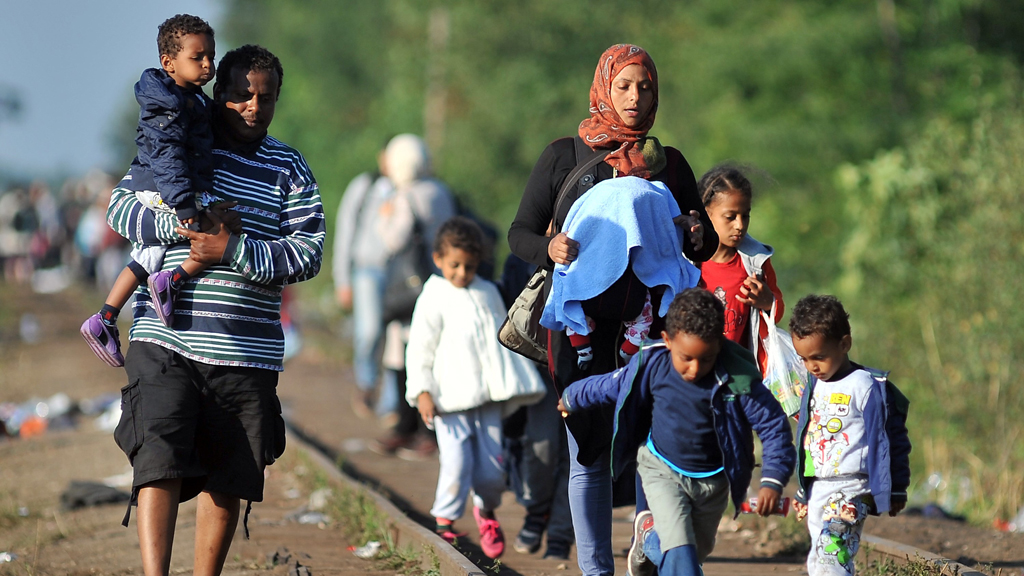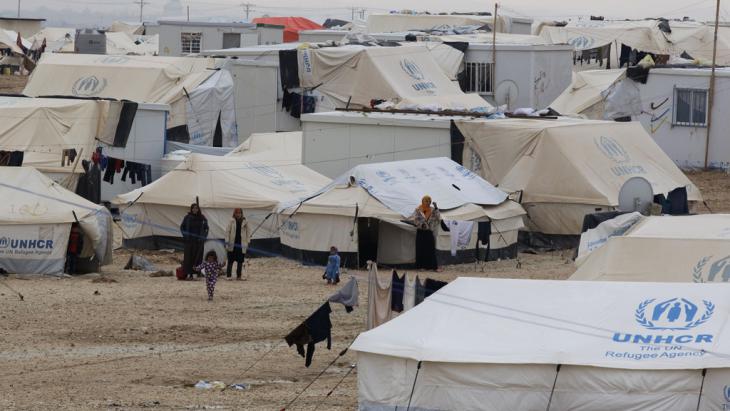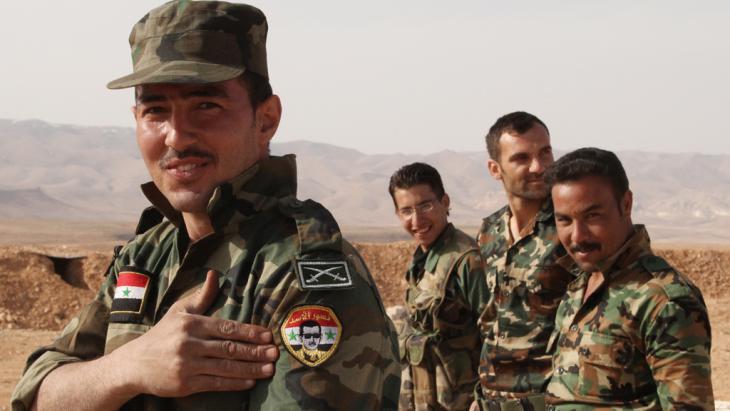"Stop Assad's bombs, then we'll go back"

Abou Adnan had to pass through 20 checkpoints with forged papers. "Your heart stops every time, because you know you could be arrested at any moment," the 26-year-old doctor writes for "The Syria Campaign", an Internet appeal by Syrian civilian society. It is nigh on miraculous that he managed to reach Germany just a few weeks ago, from the eastern suburbs of Damascus. This is because Eastern Ghouta is one of the regions hardest hit by the war in Syria: sealed off for years by the Assad regime, subjected to a poison gas attack in 2013, and under perpetual bombardment - "eight air raids a day on average" according to Abou Adnan's reckoning.
The trainee surgeon is one of more than 109,000 Syrians who have made an application for asylum in Germany, and more precisely one of around 34,000 young Syrian men who have arrived here illegally via the Mediterranean and the Balkan route. Many Germans are wondering why so many Syrians are thronging its borders now. But most of those arriving in Europe at the moment have already been on the move for a long time – either as displaced persons within their home country searching for a safe haven, or as persons stranded in neighbouring countries now searching for new prospects.
The Syrians have found neither of these things. This is also because the international community is doing too little to enable Syrians to live and survive in their homeland and the region as a whole. For this reason, anyone with savings – or a man in the family who can earn the money to finance the trip by working illegally en route – is heading for western Europe, a place where there is both security and future prospects.
The first refugees were activists
This all makes sense so far. But a closer look is needed if, as Europe's politicians continue to demand all the more vociferously, we are to tackle the causes of their exodus.
The first Syrian refugees were activists who fled into Lebanon or Jordan from April 2011 onwards. They took themselves to safety because as protagonists of the revolution, they were being shot, pursued, arrested and tortured to death by the Assad regime. From February 2012, larger groups of civilians were displaced as the regime started bombing residential districts. The first missiles hit Baba Amr, the neighbourhood of Homs where the US journalist Marie Colvin and the French photographer Remi Ochlik were killed. There followed all-out civil war, which has reigned in Syria for three-and-a-half years, devastating entire streets, districts and towns.

Since then, the number of civilians seeking refuge has increased from month to month, 12 million Syrians are viewed as displaced – more than half the original population. Most of them, around eight million, continue to wander around the country itself, which is not surprising in view of the effectively closed borders around it. More than four million have managed to enter neighbouring countries and have been registered by the UNHCR, yet the actual number of Syrians in Lebanon, Turkey and Jordan is significantly greater.
In view of the burden they represent, Syrians are no longer welcome in these countries. They are not allowed to work legally, most children do not attend school (in Lebanon 78 per cent), they vegetate in ramshackle camps without water and electricity (Lebanon), survive in big cities by begging and working illegally (Turkey) or wait in isolated tent cities in the desert (Jordan). All bearable for a few weeks or months, but for the next few years, and possibly for the rest of their lives?
With fading hopes for a solution to the conflict and a return to their homeland, comes an increasing desire to make a new beginning elsewhere. Add to this the success stories – the brother in Frankfurt, a cousin in Vienna, a neighbour in Sweden, they've all been given asylum. This spurs people to carry on, towards Europe.
For refugees coming directly from Syria, Turkey and Lebanon in particular are now only transit nations. Syria has disintegrated into four zones of influence, ruled by 1. the Assad regime, 2. various rebel groups, 3. the PKK-affiliated Kurdish Democratic Union Party (PYD) and 4. the self-styled "Islamic State" (IS). Syrians are coming to us from all four zones, although for different reasons.
We are familiar with the reasons why people are fleeing the IS terror regime, although it is possible to live under IS rule as long as you are a Sunni (as most people are in the Syrian regions controlled by IS), you uphold the horrendous rules and accept that personal freedom is the price you pay for stable food prices.
Assad's "terror from the air"
Indeed, the key reason for displacement in Syria is not IS, but Assad. The regime's air force is killing at least seven times as many people as IS. This "terror from the air", as it is referred to by civil groups, is destroying all those areas controlled by rebels – both moderate and Islamist. The aid organisation Doctors Without Borders reported that in August "heavy bombardments were carried out on 20 consecutive days in besieged Eastern Ghouta" where it is supporting 12 provisional underground clinics and where Abou Adnan also conducted operations. One in every four victims – whether dead or injured – was a child under the age of five. The future surgeon wants to at last "learn normal operations instead of pulling shrapnel out of children's legs," says Abou Adnan, explaining that this is why he is in Germany.

Those seeking to escape the regime air raids but don't make it over Syria's borders, find refuge either in the Kurdish PYD areas in the north, or paradoxically in Assad's heartland – the centre of Damascus or the coastal provinces of Lattakia and Tartous. These areas do come under rebel attack and are sporadically hit by IS bombs, but in comparison to regions hit by the regime's barrel bombs, they are considerably safer.
People here are harassed by local Shabiha militia leaders and watched by intelligence agencies. Keeping silent and keeping your head down are therefore the most crucial survival strategies in the regions controlled by Assad.
But there are signs of increasing displeasure among Assad supporters, above all among the Alawites, the confessional group to which the Assad clan also belongs. The Alawites have sacrificed too many sons to keep Bashar al-Assad in power, without receiving anything in return. On the contrary, they feel threatened by IS or radical rebel groups, while Assad himself only continues to survive with the help of Iran and Lebanese Hezbollah.
Fleeing forced recruitment
The fact that Russia is developing a military airfield on the coast, and sending in soldiers and material, serves as further proof that Assad can no longer protect the area. His army is on its last legs, not least because the regime doesn′t appear to care about troops that are captured or trapped by the rebels, all of which enhances the sense that they are Assad's cannon fodder. It is young Alawites in particular who are fleeing to Europe to avoid forced recruitment.
Kurds from Qamishli and other places in the Rojava region administered by the PYD are also fleeing military service. Since men between the ages of 18 and 35 have had to join the people's defence units in fighting IS, many are leaving the country. Afrin, the most westerly of the three Kurdish cantons has therefore even imposed a travel ban. After all, if more and more Syrian Arabs in Afrin seek refuge from Assad's bombs, and Syrian Kurds leave at the same time, the PYD fears a demographic shift to the detriment of the Kurds.
So what can be done to ensure that Syrians stay at home, or return there? According to Abou Adnan, most of his compatriots have only one wish: protection zones that would save lives and enable many to return home. "I'd be the first on the plane back home," says the 26-year-old.
Kristin Helberg
© Qantara.de 2015
Translated from the German by Nina Coon
